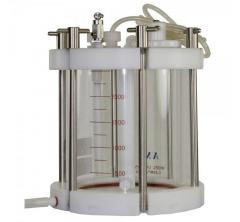Polymeric Stirred Cells
Our stirred cells have a tangential flow design to increase membrane and sample life.
Polymetric Stirred Cell Product Benefits:
- All contact surfaces are non-metal
- Clear plastic reservoir allows for visual monitoring of fluid level and sample condition
- Pressure relief valve supplied
- Cell bodies available in acrylic or autoclavable Polysulfone
Interested in learning how to operate our membrane process equipment? Check out our MPD channel to watch videos now! Membrane Process and Equipment Guide and Demonstrations
| SKU | Product Name | Diameter (mm) | Capacity | Material Type | Est Ship | Price | ||
|---|---|---|---|---|---|---|---|---|
 | 31351500 | UHP-150K Acrylic Stirred Cell, 150mm | 150 | 2000 | Acrylic | 3-4 weeks | $5,681.81 | |
 | 31351400 | UHP-90K Acrylic Stirred Cell, 90mm | 90 | 900 | Acrylic | 3-4 weeks | $3,043.97 | |
 | 31351300 | 76mm Polysulfone Stirred Cell | 76 | 380 | Polysulfone | 3-4 weeks | $2,178.89 | |
 | 31351200 | 62mm Polysulfone Stirred Cell | 62 | 200 | Polysulfone | 3-4 weeks | $1,850.62 | |
 | 31351100 | 43mm Polysulfone Stirred Cell | 43 | 70 | Polysulfone | 3-4 weeks | $1,428.59 | |
 | 31351000 | 25mm Polysulfone Stirred Cell | 25 | 10 | Polysulfone | 3-4 weeks | $1,278.53 |
Applications
Polymeric Stirred Cell Applications:
- Desalting and concentrating proteins, enzymes, virus, and other biological samples.
- Filtering fluids that contain a heavy particle burden, e.g. bacteria, silts.
- Membrane testing at low pressure, MF, UF
Specifications
UHP-K Type Stirred Cell Specifications:
| UHP-25K (31351000) | UHP-43K (31351100) | UHP-62K (31351200) | UHP-76K (31351300) | UHP-90K (31351400) | UHP-150K (31351500) | |
|---|---|---|---|---|---|---|
| Filter Size | 25 mm | 43 mm | 62 mm | 76 mm | 90 mm | 150 mm |
| End Cap & Stir Rod | Polysulfone (PSF, not end cap but Top cap) |
Polysulfone (PSF, not end cap but Top cap) |
Polysulfone (PSF, not end cap but Top cap) |
Polysulfone (PSF, not end cap but Top cap) |
Polysulfone |
Polysulfone |
| Cell Barrel | Polysulfone (PSF) | Polysulfone (PSF) | Polysulfone (PSF) | Polysulfone (PSF) | Acrylic | Acrylic |
| O-Rings | Silicone | Silicone | Silicone | Silicone | Silicone | Silicone |
| Stir Bar | Polysulfone (PSF) | Polysulfone (PSF) | Polysulfone (PSF) | Polysulfone (PSF) | Polyacetal | Polysulfone (PSF) |
| Autoclavable | Yes | Yes | Yes | Yes | No | No |
| Pressurizing Connections | PT 1/8" | PT 1/8" | PT 1/8" | PT 1/8" | M10 | M10 |
| Vent Valve Connection | 10 mm Screw, Female | 10 mm Screw, Female | 10 mm Screw, Female | 10 mm Screw, Female | M10 | M10 |
| Max. Pressure | 0.49 Mpa (71 psi) | 0.49 Mpa (71 psi) | 0.49 Mpa (71 psi) | 0.49 Mpa (71 psi) | 0.49 Mpa (71 psi) | 0.49 Mpa (71 psi) |
| Vent Relief Valve Pressure | 0.39 ± 0.09 Mpa (57 ± 13 psi) | 0.39 ± 0.09 Mpa (57 ± 13 psi) | 0.39 ± 0.09 Mpa (57 ± 13 psi) | 0.39 ± 0.09 Mpa (57 ± 13 psi) | 0.39 ± 0.09 Mpa (57 ± 13 psi) | 0.39 ± 0.09 Mpa (57 ± 13 psi) |
| Max. Operating Temp. | Autoclavable at 121°C, 20 minutes for Main body | Autoclavable at 121°C, 20 minutes for Main body | Autoclavable at 121°C, 20 minutes for Main body | Autoclavable at 121°C, 20 minutes for Main body | Not Autoclavable, 40˚C (104˚F) | Not Autoclavable, 40˚C (104˚F) |
| Diameter | 97mm | 108mm | 132mm | 146mm | 144mm | 215mm |
| Height | 140mm | 164mm | 198mm | 212mm | 222mm | 263mm |
| Weight | 0.8 kg (1.76 lb) | 1.0 kg (2.20 lb) | 1.8 kg (3.97 lb) | 2.2 kg (4.85 lb) | 3.97 lb (1.8 kg) | 8.60 lb (3.9 kg) |
| Capacity | 10 mL | 70 mL | 200 mL | 380 mL | 900 mL | 2000 mL |
| Minimum Recovarable Upstream | 0.5 mL | 2.5 mL | 4.5 mL | 10 mL | 15 mL | 60 mL |
| Downstream Holdup | 0.1 mL | 0.2 mL | 0.3 mL | 0.4 mL | 0.6 mL | 1.6 mL |
Documentation
 Frequently Asked Questions
Frequently Asked Questions
Q: I have a membrane sample that is too large to fit in my stirred cell. Can I cut it to fit?
Yes, you may cut the membrane to fit in your stirred cell. You can use the support disk from the stirred cell as a template.
Q: What type of stir plate do you recommend for use with the stirred cells?
Any conventional magnetic stir plate will work. Sterlitech recommend the Scilogex MS7-H550-Pro. The large 7in square ceramic base provides a good foundation for the stirred cells while the digital display ensures precise repeatable control of the stirring function.
Q: Can I use the aluminum oxide (AO) membrane disk filters in the stirred cells?
Yes, you can use the AO membrane disc filters in the stirred cells. These disk filters are very brittle and must be handled with an abundance of care to avoid breakage. Use membrane tweezers to carefully place the disk filter on the surface of the support disk and then install the support disk in the stirred cell body.
Q: Can I use microfiltration membrane disk filters in the stirred cells?
Yes, you can use almost all microfiltration membrane disk filters in the stirred cells. The only exception are the ceramic membrane disk filters; these are too thick to fit in the stirred cells.
Q: What do I need to operate a stirred cell?
You can find a diagram for a typical stirred cell system at https://www.sterlitech.com/media/wysiwyg/Manual/HP4750_Flow_Diagram.png. In addition to the stirred cell itself, the user will require a pressure source consisting of a regulated supply of compressed inert gas or air, a bleed valve for releasing the air pressure, an appropriately sized magnetic stirring plate, and a permeate collection vessel (e.g. flask or beaker) to collect the filtrate.
Q: Do I need to precondition the membrane disk used in a stirred cell?
Yes, for flat sheet membranes that will be used with water or aqueous solutions, we recommend that you pre-condition the membranes prior to conducting your separation experiments. Pre-conditioning helps ensure that the membranes perform as expected. Also, pre-conditioning removes preservatives and other residuals from the membranes.
To pre-condition the membrane disk, install it in the stirred cell and then fill the stirred cell with purified deionized water. Initiate operation of the stirred cell at the pressure and temperature expected for the separation experiments. Allow the cell to operate until the permeate flux has stabilized at an expected value. Then release the pressure, discard any water remaining in the stirred cell, and discard the water from the permeate collection vessel. You may now proceed with your experiments by refilling the cell with the desired feed sample. At no time should the wetted membrane disk be allowed to dry.
Q: Do you have operating manuals for the stirred cells?
Yes, we offer operating manuals for the HP4750, HP4750X, UHP polymeric stirred cells. You can find links to the operating manuals for the stirred cells by clicking on the “Documention/Media” tab on the stirred cell product pages.
Q: Why am I not achieving the membrane manufacturer’s published rejection and/or permeate flux while using my stirred cell?
It is important to note that membrane manufacturer’s specifications for rejection and permeate flux are usually based on testing of large area spiral wound membrane elements operating in crossflow mode using standardized feed streams and pressures. It is normal, and to be expected, that rejection and permeate flux will be different for feed streams and pressures that are not similar to the standardized test conditions. It is also normal, and to be expected, that rejection and permeate flux will have greater variability from published specifications for devices with membrane active areas that are very much smaller than spiral wound elements, such as stirred cells. Some amount of concentration buildup in the feed for stirred cells is inevitable and this may affect rejection and permeate flux.
There are some tactics that can be used to optimize rejection and permeate flow while using stirred cells. First, the membrane should be pre-conditioned using purified deionized water. Please refer to the operating manual for the pre-conditioning procedure. Second, make sure that the stir bar is turning properly and at an appropriate rate. Third, the operating pressure should correspond to the membrane manufacturer’s recommended pressure. Finally, you may want to stop your experiments while there is still some feed liquid remaining in the stirred cell to mitigate effects associated with increasing concentrations.
Q: Can I attach the stirred cell permeate line directly to an HPLC analyzer or other laboratory instruments?
Yes, you may connect the permeate line directly to an instrument. However, it is important to understand that if the membrane fails or is allowed to dry, then the full feed pressure may be applied to the permeate line. If the instrument cannot withstand the feed pressure, then directly connecting the permeate line is not recommended. Alternatively, if the membrane becomes prematurely fouled (due to a high TDS or particulate loading), permeate levels may drop below detection in the HPLC inlet port.
Q: What is the maximum membrane thickness for the stirred cells?
The stirred cells are designed to accept flat sheet membranes with thickness of 350 microns or less.
Q: What is the pore size rating for the porous support disc (SKU 1114910)?
The porous support disk has a nominal pore size of 20µm.
Q: I cannot find the correct size membrane disk for my polymeric stirred cell listed in the ordering information for the membrane filters or the crossflow flat sheet membranes. Can I order these membranes in the correct size?
Yes, we do offer membrane disks in the correct sizes for the polymeric stirred cells. Please contact us for pricing and availability.
Q: What is the maximum operating temperature for the polymeric stirred cells?
The maximum operating temperature for the polymeric stirred cells is 104°F (40°C).
Q: Do you offer replacement parts for the polymeric stirred cells?
Yes, we do offer replacement parts for the polymeric stirred cells. You can refer to the operating manual for part diagrams and part numbers. Please contact us for pricing and availability.
Q: Can the polymeric stirred cells be autoclave sterilized?
The UHP stirred cells with acrylic or polycarbonate barrels cannot be autoclave sterilized. The UHP-K polyethersulfone stirred cells can be autoclave sterilized using a 20min cycle at 121°C. The stirred cells must be allowed to cool to 40°C or less before use.
Q: Why is the flat sheet membrane I'm using measuring a flux value less than the published flux value?
Flow characteristics for a spiral element and flat sheet membrane are significantly different and are really only comparable on a qualitative basis. Variability in the membrane manufacturing process, differences in water composition, test procedures, and test equipment, used in a factory, laboratory, or elsewhere, will impact water flux results.
Q: How do I release the pressure on a stirred cell?
The user must completely release the pressure before opening a stirred cell. The HP4750 and HP4750X stirred cells do not have integrated pressure relief valves, but Sterlitech does offer an accessory bleed valve for purchase which can be attached to the regulator's outlet to the high pressure hose upstream of the stirred cell. https://www.sterlitech.com/pressure-relief-bleed-valve-2500-psig-1155893.html . The bleed valve can be slowly opened to release pressure when necessary for sample removal or refilling.
The polymeric stirred cells have integrated pressure relief valves. These valves can simply be opened to release the pressure when necessary.



